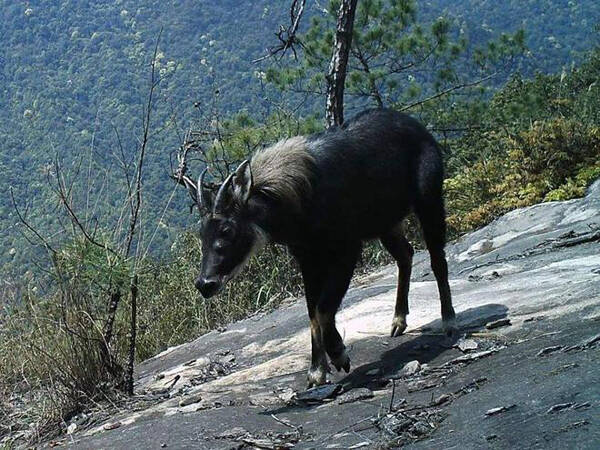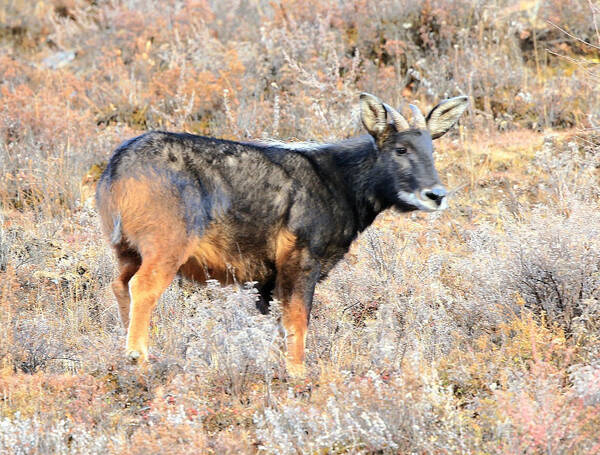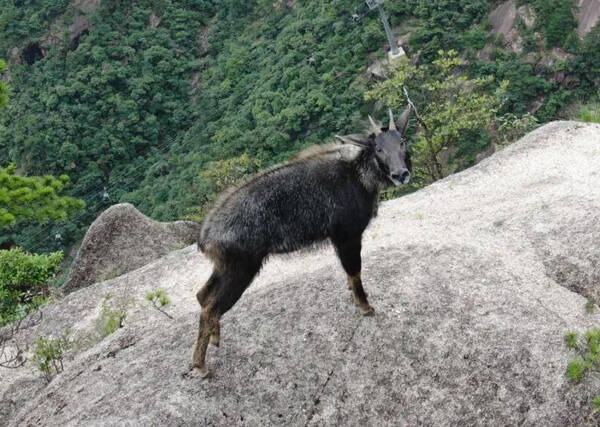Capricornis sumatraensis
IUCN
LCBasic Information
Scientific classification
- name:Capricornis sumatraensis
- Scientific Name:Sumatran serow, Ming mane sheep, mountain donkey, rock donkey, four-legged beast, Pegasus, shepherd
- Outline:Ungulata
- Family:Artiodactyla Bovidae Serow
Vital signs
- length:140-180cm
- Weight:50-140kg
- lifetime:About 15 years
Feature
It is similar in shape to a goat or antelope and is named for the gray-white mane on the back of its neck.
Distribution and Habitat
Distributed in Bangladesh, Bhutan, Cambodia, China, India, Indonesia, Laos, Malaysia, Myanmar, Nepal, Thailand and Vietnam.
The serow is a forest-dwelling mammal that inhabits rugged, steep slopes and rocky terrain at altitudes of 100-4,000 m. It has also been recorded in temperate coniferous and broad-leaved forests in Nepal and southwestern China and northwestern Yunnan, and in dense shrubs of rhododendron and vaccinium in Vietnam. It also inhabits lowland montane forests with gentler terrain, including flat areas with shrubs. Serows also live on small offshore islands, such as Cat Ba Island in northern Vietnam and small islands off the coast of northern Thailand's peninsular coast. While serows are sensitive to human disturbance, they appear to tolerate moderately degraded forests and isolated small limestone hills and cliffs in natural karst scrub and even disturbed habitats.
Appearance
Serow is of medium size, with a body length of about 140-180 cm, a tail length of about 6-16 cm, a shoulder height of about 85-94 cm, and a weight of about 50-140 kg. It is similar to a goat or antelope in body shape. There are long manes on the back of the head and the nape of the neck. It is named after the grayish-white mane on the nape of the neck. They have well-developed auricles, and the ears are 16-17 cm long. The infraorbital glands are large and obvious. The limbs are strong and powerful, and the whole body is covered with coarse and hard hair, usually dark gray or black. The upper body is brown-gray, gray-white or black. The neck has a well-developed mane, the upper and lower lips and the inside of the ears are gray-white, the back and tail end of the tail are black, and there is a distinct black stripe along the back. The chest is similar to dark brown or black, and the armpits and muzzle are rusty yellow or brown-white. The limbs are yellow-brown below the knee joints, and
Details
Capricornis sumatraensis (English: Mainland Serow, Serow, Spanish: Serau de Sumatra, German: Südlicher Serau), has three subspecies, namely Sumatran Serow (nominal subspecies), Chinese Serow and Himalayan Serow. In ancient times, it was called "Heavenly Horse". According to the Records of Huangshan Mountain, "Heavenly Horse often flies over the peaks of Tiandu Lotus", "with silver mane and golden hair, four feet holding auspicious clouds, and beard jumping over dozens of peaks". According to research, the Heavenly Horse is the Serow. Because it can jump on steep walls, its movements are light and agile, and the clouds and mist add a mysterious color of stepping on auspicious clouds and flying over the abyss, it is called "Heavenly Horse". The aliases of Serow include Sibu Xiang, Shan Donkey, Ming Zong Sheep, and Chang Zong Sheep. Such many and confusing common names more or less reflect the peculiarity of its appearance.

In summer, the hyena likes to rest in secluded places such as under big trees, in bushes and between huge rocks; in winter, they often take shelter in caves and spend the night. There are relatively fixed paths for foraging, resting places and defecation sites. They usually appear between cliffs or hide in dense forests. Each individual or small group occupies a certain territory. Because of the well-developed infraorbital gland and hoof gland, they can use their secretions to mark the territory on trees or bushes at the edge of their habitat. They are very good at climbing and jumping, and can move freely between the steepest cliffs or jump like flying between rocky valleys. This is because its hoof is composed of two hooves close together, with a narrow tip at the front and a wide back, surrounded by keratin and a soft part in the middle, like a suction cup, which enables it to stand or jump steadily on steep rocks. In addition, there are sensitive peripheral receptors at the bottom of its limbs. When active, after the hoof receives stimulation from the bottom, the receptors can convert it into a signal and transmit it to the central nervous system. The central nervous system converts the received signal into a control signal and then transmits it to various muscle groups on the limbs, thereby adjusting the balance of the body's center of gravity. When disturbed, it can run quickly, jump over dangerous rocks, climb to the top of cliffs to avoid enemies, and will not return after escaping.
Serows usually live in small groups of 5-6 and are relatively solitary. In addition to males who always move alone, females and their cubs also form small groups of 4-5 at most, and never larger groups. They come out in the clearings in the forest in the morning and evening. When they are forced to escape, they use their two hind hooves to support their bodies, stand upright, and use their two front hooves to desperately hit the rocks, making a crisp "crackling" sound, or hitting their bellies like "dong dong" like beating drums, the sound resounding through the valley, in order to intimidate enemies. If this trick doesn't work, they will also stand up to defend themselves, bravely and resolutely counterattack with their horns to attack the opponent. Adult males are more ferocious and strong, and can often break out of the encirclement of natural enemies, or defeat opponents who are not too big and push them off the cliff.
Serow feeds and drinks at the edge of forests or in gullies. It feeds mainly on various weeds, grasses, young branches, leaves, buds, fallen fruits, fungi, usnea, etc. The species' habitat selection in winter and summer is different based on factors such as vegetation type, tree distribution, slope, altitude, rock distribution, tree size, slope position, canopy and water source. However, the choice of shelter and concealment opportunities, as well as the distance from water, were not found to be significantly affected by season. The species feeds on leaves and branches of at least 33 different plant species out of 34 species in Cat Ba Island, Vietnam and Annapurna Conservation Area, Nepal. Most of these plant species are shrubs and low trees, so the serow is classified as a typical herbivore.

121 species of plants were recorded for the serow, of which 72 were woody plants, accounting for 60% of the food species; 38 were herbs (including 2 species of bamboo), accounting for 31%; the remaining 11 were 3 vines, 6 mosses and ferns, and 2 fungi, accounting for 9%. The serows ate the most plant species in summer, with 92 species; only 43 species were eaten in winter. Young branches and leaves of plants are the main food of serows. In the study area, the overlap between serows and takins exceeds 30%, and the overlap is as high as 48% in winter. They feed on various weeds and leaves. They eat and drink water at the edge of the forest or in the valley, mainly on grass, young branches, leaves, buds, fallen fruits, fungi, and lichens. The feces are in a pile, with 10 grains discharged each time.
Serows breed once a year, mating in September and October in autumn. There are fierce fights between males when they are chasing for mates. The winner can mate with the female, and the loser may even be gored to death. The gestation period of females is about 8 months, and the cubs are mostly born in late May to early June of the following year. Each litter has 1-2 cubs. The cubs can stand upright and eat grass one day after they are born, and can move with the female sheep a few hours later. The cubs are sexually mature at 2-3 years old, but they still live with the female at 2 years old and start to move independently at 3 years old. The life span is about 15 years.
Although the natural population of serow has a certain number, the number and distribution area of the species are decreasing due to the destruction of habitats and indiscriminate hunting and killing by humans over the years. The steep cliff environment has created a unique way of survival for serows, but due to the restrictions on human activities by the cliff environment, it is difficult for humans to conduct in-depth research and understanding of the species. Many aspects are in a state of half-understanding, and systematic research is urgently needed.

Although the range of the serow covers more than 11 countries, its populations are fragmented, isolated, and declining rapidly due to poaching, habitat loss, and destruction throughout its range. These factors, combined with the unavailability of reliable data on the abundance and distribution of the species, make it difficult to implement effective conservation actions for long-term protection. Therefore, based on local surveys, the serow has declined by more than 30% within three generations, the area occupied and the quality of the habitat have declined, and the actual level of exploitation has been estimated. Urgent conservation action is required for this species.
The nominate subspecies Sumatran serow (Capricornis sumatraensis sumatraensis) is assessed as Vulnerable (VU A2; C1) because it is believed to have declined significantly due to overhunting and severe habitat loss. Chinese serow (Capricornis sumatraensis milneedwardsii) and Himalayan serow (Capricornis sumatraensis thar) were previously assessed as Near Threatened. New data and information indicate that as of 2020, these subspecies are experiencing significant declines in population size, distribution range, and their habitat over the past decade, and are expected to continue to decline significantly in the future due to strong human impacts. Therefore, both subspecies are assessed as Vulnerable (VU A2; C1).
Serow is a typical forest-dwelling mammal. Like other forest animals, its habitat has been destroyed as forests in its distribution area have been cut down in large quantities. In addition, because serow is large in size, it can provide more meat, and its skin is of high quality. Therefore, before the 1980s, it was often hunted in various provinces and regions in southern China. Therefore, habitat destruction and indiscriminate hunting are the main factors that endanger it. Although this animal is protected by Chinese national law, poaching has not been completely eliminated in some places.
In Indonesia, serow has been protected by law since 1932. In the protected area system, a total of 3,083,308 hectares of serow habitat are protected in some form, including three national parks, three wildlife sanctuaries, three nature reserves and two protected forests. The species is fully legally protected in Peninsular Malaysia under the Wildlife Protection Act 2010, which means that hunting of the species is prohibited. In Laos, the species may be at risk. However, Cambodia, Myanmar and Thailand appear to have no actual legislation aimed at protecting the Serow. In Vietnam in 2006, the animal was listed as IB (no hunting allowed) in the list of 32 endangered and rare species, and in 2008, the animal was listed as endangered (E) in the Red Book of Vietnam. The animal is protected under the Indian Wildlife Protection Act and Schedule I of the Bhutan Forest and Nature Conservation Act, which prohibit all hunting. In Nepal, hunting is prohibited by law. The Serow is protected under Schedule I of the Indian Wildlife Protection Act (WLPA, 1972) and the Bhutan Forest and Nature Conservation Act, which prohibit all hunting activities. In Nepal, its hunting is also completely prohibited by law (Wegge and Oli, 1997).
In 1962 and 1980, the "Wildlife Protection Regulations" (Draft) formulated by the Ministry of Forestry of China listed the serow as a protected animal. In the "National Key Protected Wildlife List" promulgated by the Chinese government in 1988, this species was classified as a Class II protected animal. Among the established nature reserves, there are about 30 places where the serow is protected.
Listed in the "Red List of Endangered Species of the World Conservation Union" (IUCN) 2020 ver3.1-Vulnerable (VU).
Listed in Appendix I of the Convention on International Trade in Endangered Species (CITES).
Listed as vulnerable (VU) in the "Red List of Chinese Species" and the "Red Data of Endangered Animals in China".
Listed as a Class II protected animal in China.
Protect wild animals and stop eating game.
Maintaining ecological balance is everyone's responsibility!








